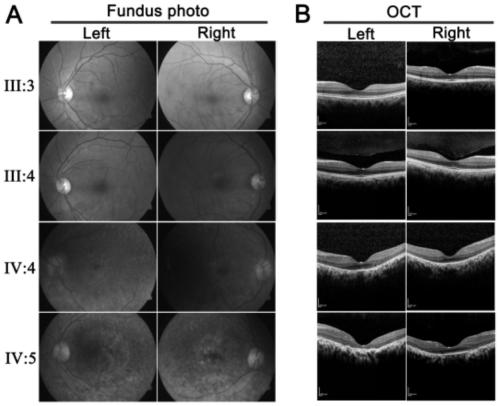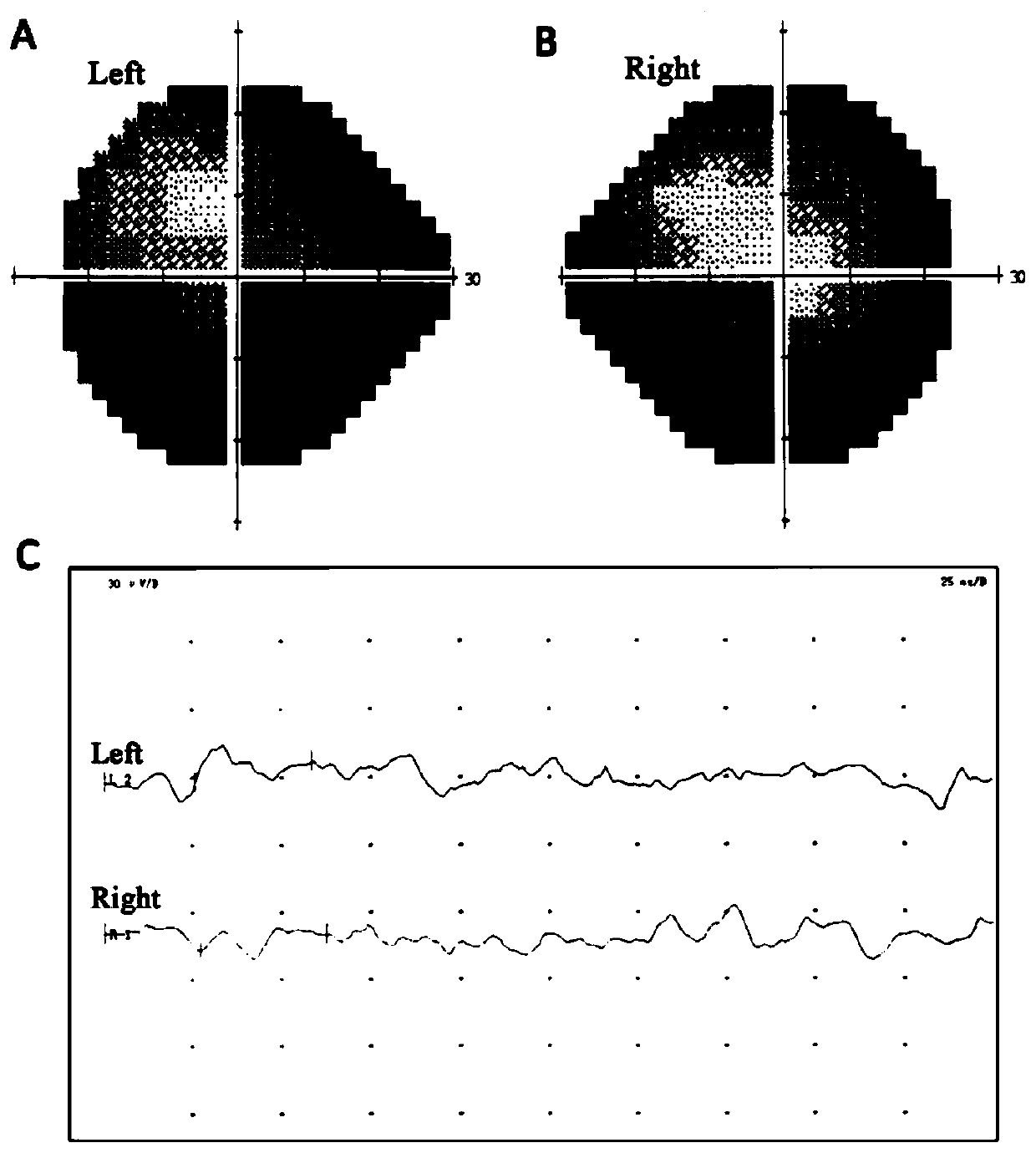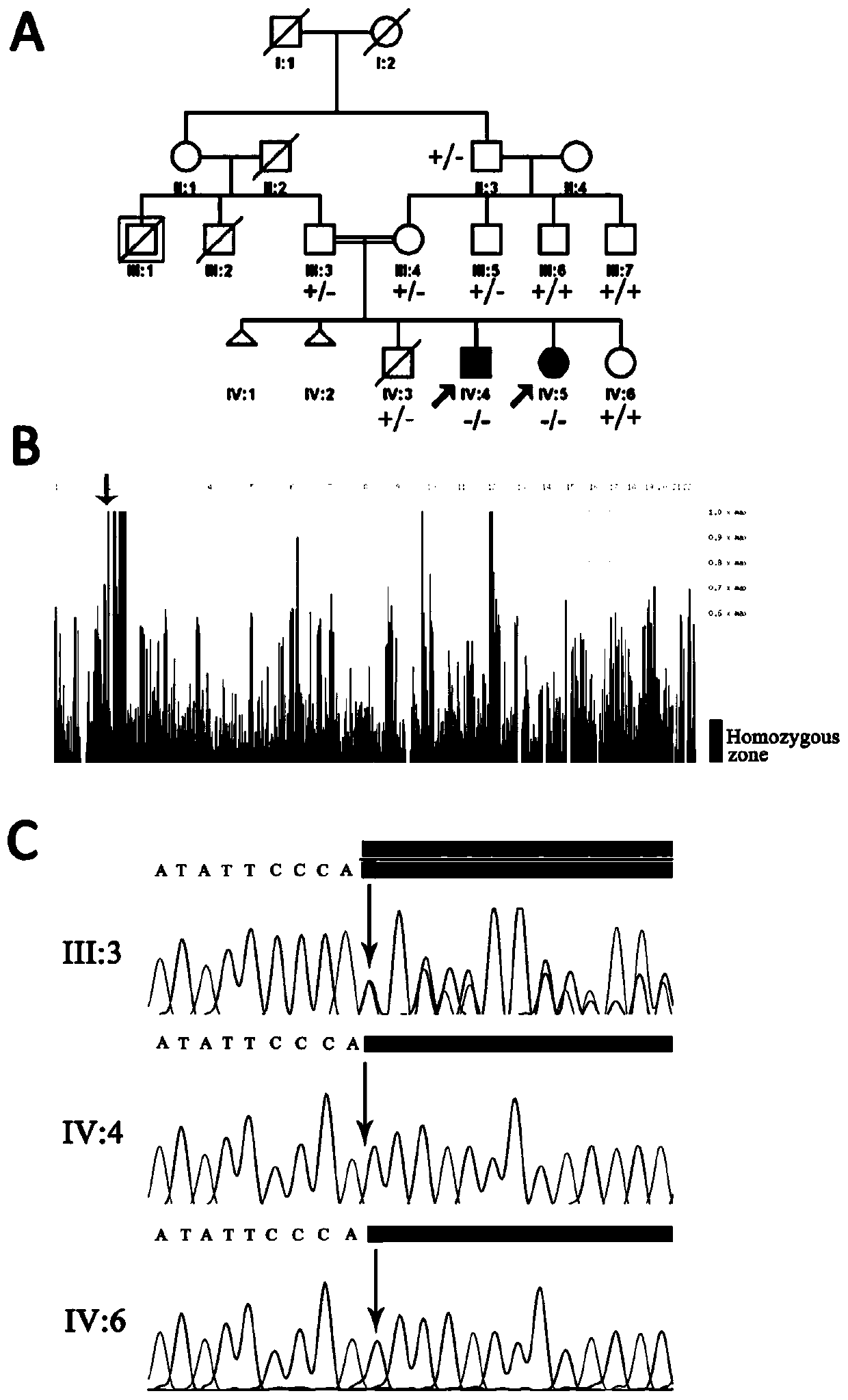Application of ZNF124 gene in early screening or auxiliary diagnosis of retinal pigment degeneration disease
A technology for retinal pigmentation and degenerative diseases, applied in the field of gene detection, can solve the problem that the disease-causing gene has not been found yet
- Summary
- Abstract
- Description
- Claims
- Application Information
AI Technical Summary
Problems solved by technology
Method used
Image
Examples
experiment example 1
[0050] Family analysis and discovery of ZNF124 mutation
[0051] Among the collected RP families, the RP074 family is a Han nationality with autosomal recessive retinitis pigmentosa in Southwest China, with 13 members in 3 generations, and 2 of them suffered from RP. Clinical examination showed that the probands IV:4 and IV:5 of the RP074 family had poor night vision from the age of 15, and gradually developed night blindness and impaired peripheral vision. Fundus examination showed optic nerve head atrophy in both eyes, retinal artery stenosis, and retinal pigmentation ( figure 1 Middle A), retinal optical coherence tomography (Optical Coherence tomography, OCT) showed that the neuroepithelium of the patient's retina became thinner, and the outer nuclear layer was the most obvious; the reflection of the inner and outer segmental junction layers of photoreceptors disappeared, and some of them were discontinuous; the pigment epithelial cells partially lost and changed Thin, at...
experiment example 2
[0054] Further data analysis of the collected whole-exome sequencing RP samples in which no known gene mutations were detected revealed that another autosomal recessive RR family, RP131, carried the ZNF124 mutation. RP131 is a Han RP family in northern China ( Figure 4 Middle A). The proband carried a homozygous mutation of ZNF124 ( Figure 4 Middle B), whose parents are heterozygous carriers. The proband was a male patient who developed night blindness and progressive visual atrophy around the age of 20.
[0055] This mutation site has not been detected in dbSNP database, 1000Genomes, NHLBI Exome Sequencing Project (ESP), the ExAC Browser (Beta), gnomAD database, which is a rare mutation. The mutation was not detected in 3,000 healthy control samples. This splicing mutation results in a clipping deletion of the coding region after codon 73, resulting in a frameshift mutation; the mutated ZNF124 protein retains only the N-terminal KRAB-A box domain, these data suggest tha...
experiment example 3
[0057] In order to detect the effect of the deletion mutation (NM_003431:exon5:c.219-1G>-) on the transcription and translation of ZNF124 protein, the peripheral blood RNA of the RP074 proband and his parents was extracted and reverse transcribed into cDNA, the method is as follows:
[0058] (a) Separate the peripheral blood leukocytes, place them in a 1.5ml centrifuge tube, add 1ml Trizol extract, and keep at room temperature for 20 minutes;
[0059] (b) Add 200 μl of chloroform, mix thoroughly, and let stand at room temperature for 10 minutes;
[0060] (c) The sample is placed in a centrifuge at 4 degrees, and centrifuged at 10,000 rpm for 15 minutes;
[0061] (d) Carefully absorb the supernatant, add an equal volume of isopropanol, mix thoroughly, and centrifuge at 10,000 rpm to precipitate RNA;
[0062] (e) Wash the precipitated total RNA with 75% ethanol, centrifuge to precipitate again, then dry and add DEPC water to dissolve;
[0063] (f) cDNA was synthesized from the...
PUM
 Login to View More
Login to View More Abstract
Description
Claims
Application Information
 Login to View More
Login to View More - R&D
- Intellectual Property
- Life Sciences
- Materials
- Tech Scout
- Unparalleled Data Quality
- Higher Quality Content
- 60% Fewer Hallucinations
Browse by: Latest US Patents, China's latest patents, Technical Efficacy Thesaurus, Application Domain, Technology Topic, Popular Technical Reports.
© 2025 PatSnap. All rights reserved.Legal|Privacy policy|Modern Slavery Act Transparency Statement|Sitemap|About US| Contact US: help@patsnap.com



